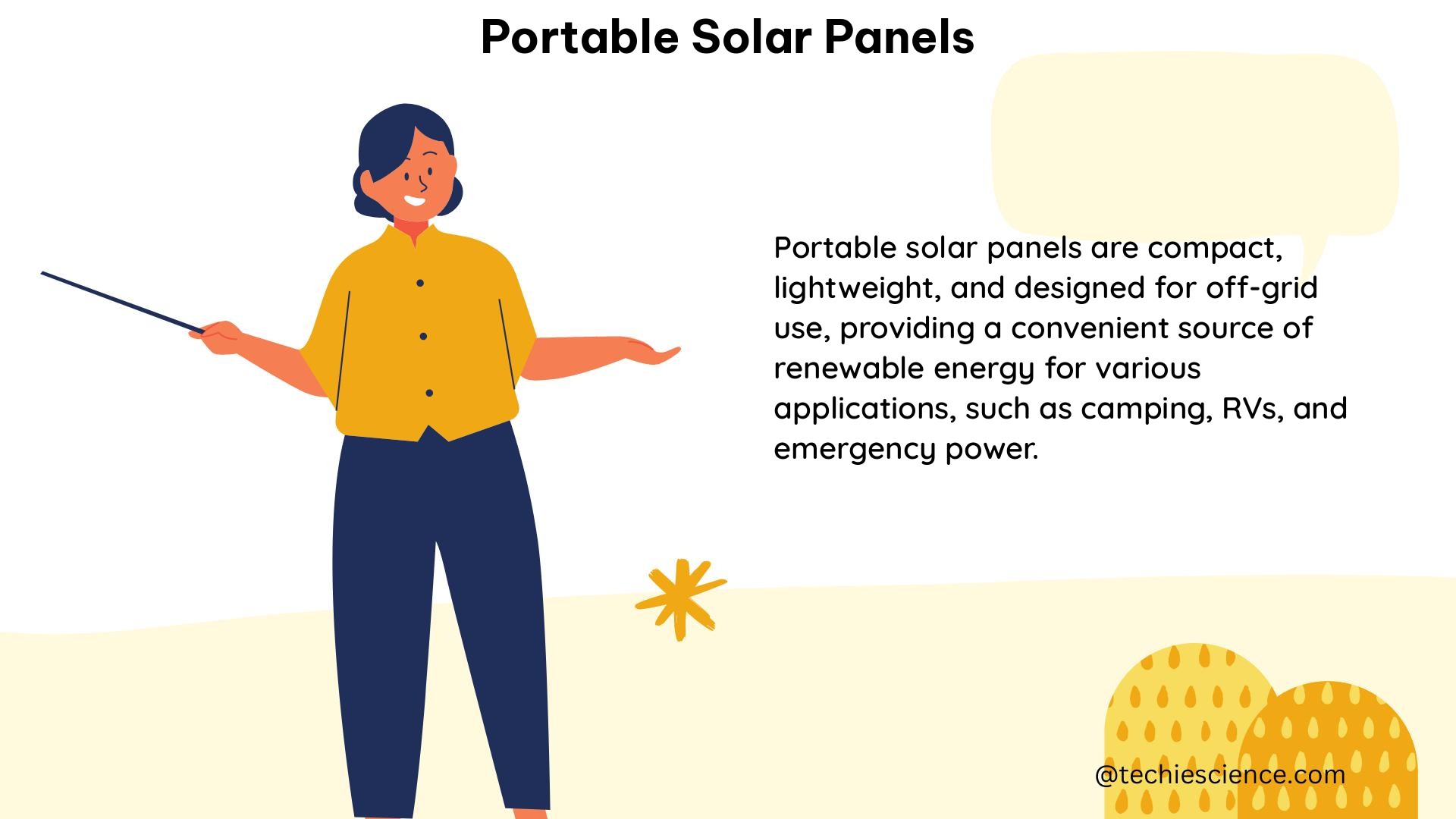Portable solar panels are a versatile and efficient way to generate electricity, especially in remote or off-grid locations. They come in various sizes, wattages, and configurations, making them suitable for a wide range of applications. This comprehensive guide will delve into the technical details and measurable data points of portable solar panels, providing a valuable resource for science students and enthusiasts.
Understanding the Fundamentals of Portable Solar Panels
Size and Weight Specifications
Portable solar panels typically measure between 10 to 100 watts and weigh between 5 to 20 pounds. For example, a 50-watt portable solar panel may measure 22 x 14 x 1.2 inches and weigh around 12 pounds. The size and weight of a portable solar panel are crucial factors to consider, as they determine the panel’s portability and ease of transportation.
Power Rating and Standard Test Conditions (STC)
The power rating of a portable solar panel is measured in watts (W) and indicates the maximum amount of power it can generate under standard test conditions (STC). STC assumes an irradiance of 1000 W/m², a cell temperature of 25°C, and an air mass of 1.5. For instance, a 100-watt portable solar panel can produce up to 100 watts of power under these standard conditions.
Voltage and Current Specifications
Portable solar panels have specific voltage and current ratings, measured in volts (V) and amperes (A), respectively. These ratings are essential for determining the compatibility of the solar panel with the intended application or device. For example, a 100-watt portable solar panel may have a voltage of 18 volts and a current of 5.55 amperes.
Efficiency and Conversion Rates
The efficiency of a portable solar panel is a measure of how well it converts sunlight into electricity. It is expressed as a percentage and is calculated by dividing the panel’s power output by the amount of sunlight energy it receives. For instance, a 100-watt portable solar panel with an efficiency of 20% would produce 20 watts of power for every 100 watts of sunlight energy it receives.
The conversion efficiency of solar cells is governed by the Shockley-Queisser limit, which states that the maximum theoretical efficiency of a single-junction solar cell is around 33.7% under standard test conditions. This limit is based on the principles of thermodynamics and the bandgap energy of the semiconductor material used in the solar cells.
Temperature Coefficient and Performance Variations
The temperature coefficient of a portable solar panel indicates how much its power output decreases as its temperature increases. It is expressed as a percentage and indicates the percentage decrease in power output for every degree Celsius increase in temperature. For example, a 100-watt portable solar panel with a temperature coefficient of -0.4% would produce 99.6 watts of power at 26°C, assuming a temperature coefficient of -0.4%.
The temperature coefficient is an important consideration, as portable solar panels can be exposed to a wide range of environmental conditions, which can affect their performance. Understanding the temperature coefficient can help users optimize the placement and cooling of the solar panels to maintain optimal power output.
Solar Cell Types and Characteristics
Portable solar panels can use different types of solar cells, such as monocrystalline, polycrystalline, or thin-film. Each cell type has its own unique characteristics and performance attributes:
-
Monocrystalline Solar Cells: These are the most efficient solar cells, typically achieving efficiencies in the range of 18-22%. Monocrystalline cells are made from a single, continuous crystal of silicon, which results in a uniform and high-quality semiconductor material.
-
Polycrystalline Solar Cells: These cells are made from multiple silicon crystals, resulting in a slightly lower efficiency compared to monocrystalline cells, typically in the range of 15-18%. However, polycrystalline cells are generally less expensive to manufacture.
-
Thin-Film Solar Cells: These cells are made from thin layers of semiconductor materials, such as amorphous silicon, cadmium telluride, or copper indium gallium selenide (CIGS). Thin-film cells have lower efficiencies, typically in the range of 10-15%, but they can be more flexible and lightweight, making them suitable for certain portable applications.
The choice of solar cell type for a portable solar panel depends on factors such as efficiency, cost, weight, and specific application requirements.
Practical Examples of Portable Solar Panels

To provide a better understanding of the technical specifications and characteristics of portable solar panels, let’s examine three specific models:
- Goal Zero Nomad 50:
- Power Rating: 50 watts
- Dimensions: 22 x 14 x 1.2 inches
- Weight: 12 pounds
- Voltage: 18 volts
- Current: 2.78 amperes
- Efficiency: 22%
- Temperature Coefficient: -0.4% per degree Celsius
-
Solar Cell Type: Monocrystalline
-
Renogy 100-Watt 12-Volt Monocrystalline Portable Foldable Solar Suitcase:
- Power Rating: 100 watts
- Dimensions (folded): 47 x 21.5 x 1.8 inches
- Weight: 26.6 pounds
- Voltage: 18 volts
- Current: 5.55 amperes
- Efficiency: 21%
- Temperature Coefficient: -0.35% per degree Celsius
-
Solar Cell Type: Monocrystalline
-
BigBlue 28W Solar Charger:
- Power Rating: 28 watts
- Dimensions: 11.1 x 6.3 x 2.8 inches
- Weight: 1.3 pounds
- Voltage: 5 volts
- Current: 5.6 amperes
- Efficiency: 22%
- Temperature Coefficient: Not specified
- Solar Cell Type: Not specified
These examples illustrate the diverse range of portable solar panel options available, each with its own unique set of technical specifications and characteristics. By understanding these details, users can make informed decisions when selecting the most suitable portable solar panel for their specific needs and applications.
Advanced Considerations and Calculations
To delve deeper into the technical aspects of portable solar panels, let’s explore some advanced considerations and calculations:
Photovoltaic Effect and the Shockley-Queisser Limit
The photovoltaic effect is the fundamental principle behind the conversion of sunlight into electrical energy in solar cells. This effect is governed by the Shockley-Queisser limit, which states that the maximum theoretical efficiency of a single-junction solar cell is around 33.7% under standard test conditions.
The Shockley-Queisser limit is derived from the principles of thermodynamics and the bandgap energy of the semiconductor material used in the solar cells. It takes into account factors such as the spectrum of the incident sunlight, the energy losses due to thermalization of charge carriers, and the radiative recombination of electron-hole pairs.
To calculate the Shockley-Queisser limit for a specific solar cell material, the following equation can be used:
η_max = (V_oc * J_sc * FF) / P_in
Where:
– η_max is the maximum theoretical efficiency
– V_oc is the open-circuit voltage
– J_sc is the short-circuit current density
– FF is the fill factor
– P_in is the input power density of the incident sunlight
By understanding the Shockley-Queisser limit, researchers and engineers can work towards developing solar cell technologies that can push the boundaries of efficiency and improve the performance of portable solar panels.
Electrical Characteristics and Load Matching
The electrical characteristics of a portable solar panel, such as its voltage-current (V-I) curve and power-voltage (P-V) curve, are crucial for understanding its performance and optimizing its use.
The V-I curve of a solar panel describes the relationship between the output voltage and current, and it is influenced by factors such as the solar irradiance, cell temperature, and load resistance. The P-V curve, on the other hand, shows the relationship between the output power and voltage, and it can be used to determine the maximum power point (MPP) of the solar panel.
To maximize the power output of a portable solar panel, it is essential to match the load (e.g., a battery or a device) to the solar panel’s MPP. This can be achieved through the use of a maximum power point tracking (MPPT) charge controller, which continuously adjusts the load resistance to maintain the solar panel’s operation at the MPP.
By understanding the electrical characteristics of portable solar panels and implementing proper load matching techniques, users can optimize the power output and efficiency of their solar energy systems.
Numerical Examples and Calculations
To illustrate the application of the concepts discussed, let’s consider a numerical example:
Suppose you have a 100-watt portable solar panel with the following specifications:
– Voltage at maximum power (V_mp): 18 volts
– Current at maximum power (I_mp): 5.55 amperes
– Open-circuit voltage (V_oc): 22 volts
– Short-circuit current (I_sc): 6 amperes
– Fill factor (FF): 0.77
-
Calculate the maximum theoretical efficiency of the solar panel based on the Shockley-Queisser limit:
P_in = 1000 W/m^2 (standard test condition)
V_oc = 22 V
J_sc = I_sc / A = 6 A / (0.5 m^2) = 12 A/m^2
FF = 0.77
η_max = (V_oc * J_sc * FF) / P_in = (22 V * 12 A/m^2 * 0.77) / 1000 W/m^2 = 0.203 or 20.3%
The maximum theoretical efficiency of the solar panel is approximately 20.3%. -
Calculate the actual power output of the solar panel:
P_max = V_mp * I_mp = 18 V * 5.55 A = 99.9 W
The actual power output of the solar panel is 99.9 watts, which is close to the rated 100-watt power. -
Determine the temperature coefficient of the solar panel:
- Assume the temperature coefficient is -0.4% per degree Celsius
- If the solar panel’s temperature increases by 10°C, the power output would decrease by:
ΔP = P_max * (-0.4% / °C) * ΔT = 99.9 W * (-0.4% / °C) * 10°C = -3.996 W
The power output of the solar panel would decrease by approximately 4 watts if the temperature increases by 10°C.
These calculations demonstrate the application of the technical concepts discussed earlier, allowing users to understand the performance and characteristics of their portable solar panels in more depth.
Conclusion
In conclusion, this comprehensive guide has provided a detailed exploration of the technical aspects and measurable data points of portable solar panels. By understanding the size, weight, power rating, voltage, current, efficiency, temperature coefficient, and solar cell types, users can make informed decisions when selecting and utilizing portable solar panels for their specific needs and applications.
The guide has also delved into advanced considerations, such as the photovoltaic effect, the Shockley-Queisser limit, electrical characteristics, and load matching, as well as presented numerical examples and calculations to illustrate the practical application of these concepts.
With this knowledge, science students and enthusiasts can confidently navigate the world of portable solar panels, optimizing their performance and maximizing the benefits of this versatile and efficient technology.
References
- Adafruit. (n.d.). Portable Solar Charging Tracker. Retrieved from https://learn.adafruit.com/portable-solar-charging-tracker?view=all
- Cedar, W. W. U. (2016). Portable Solar Panels: A Comprehensive Guide. Retrieved from https://cedar.wwu.edu/cgi/viewcontent.cgi?article=1679&context=wwu_honors
- Dabbsson. (2021). Mastering Portable Solar Panels: A Comprehensive Guide to Efficient Use. Retrieved from https://www.dabbsson.com/blogs/news/mastering-portable-solar-panels-a-comprehensive-guide-to-efficient-use
- Shockley, W., & Queisser, H. J. (1961). Detailed Balance Limit of Efficiency of p-n Junction Solar Cells. Journal of Applied Physics, 32(3), 510-519.

I am Subrata, Ph.D. in Engineering, more specifically interested in Nuclear and Energy science related domains. I have multi-domain experience starting from Service Engineer for electronics drives and micro-controller to specialized R&D work. I have worked on various projects, including nuclear fission, fusion to solar photovoltaics, heater design, and other projects. I have a keen interest in the science domain, energy, electronics and instrumentation, and industrial automation, primarily because of the wide range of stimulating problems inherited to this field, and every day it’s changing with industrial demand. Our aim here is to exemplify these unconventional, complex science subjects in an easy and understandable to the point manner.